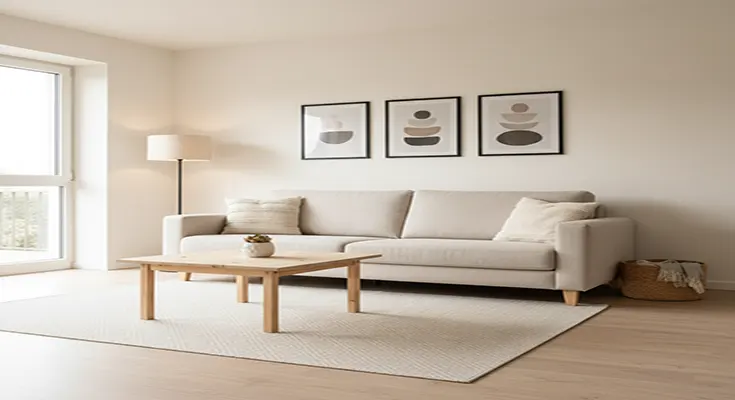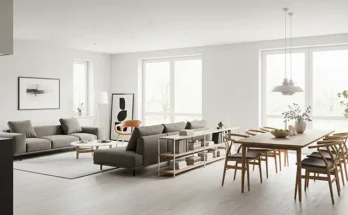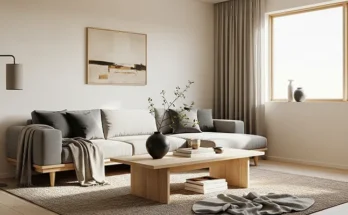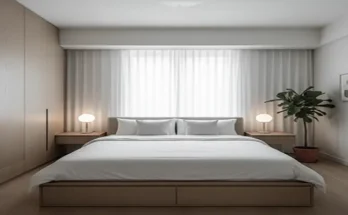Minimalism has a reputation for being chic, serene, and, sometimes, expensive. The clean, curated look of high-end, designer furniture can make achieving the aesthetic seem out of reach.
However, the core principles of minimalist design—simplicity, functionality, and intentionality—actually make it one of the most budget-friendly styles to adopt. By focusing on what you remove rather than what you buy, you can easily create a stylish, clutter-free, and tranquil minimalist living room without draining your bank account.
Here is your guide on how to decorate a minimalist living room on a budget, prioritizing clever choices over costly purchases.
Step 1: The Zero-Cost Essential – Declutter Ruthlessly
The foundation of any minimalist space is the deliberate removal of excess. This is the only mandatory step, and it costs nothing.
- Edit Your Inventory: Take a critical look at your current living room. Everything that is purely decorative, broken, or has not been used in six months should be removed. Minimalism thrives on negative space, so an empty corner is more valuable than a cluttered one.
- Embrace Hidden Storage: The easiest way to maintain a minimalist look is to hide the necessary mess. Use baskets, decorative bins, or seek out furniture with built-in storage (like a storage ottoman or a coffee table with drawers) to tuck away remotes, blankets, and magazines.
Step 2: Master the Budget-Friendly Minimalist Palette
Minimalist design relies on a restrained color scheme to create a sense of calm and spaciousness. This saves money because you avoid the high cost of patterned textiles and intricate accessories.
- Go Neutral on the Walls: A coat of neutral paint—think crisp white, soft beige, or a light gray—is one of the most cost-effective ways to transform a room. These colors maximize natural light, making the room feel larger and more open.
- Limit Your Accent Colors: Choose only one or two accent colors (such as a soft sage green or a deep charcoal) to introduce through small, replaceable items like a throw blanket, a single throw pillow, or a piece of art. The fewer colors you use, the more cohesive and clean the room will look.
Step 3: Furniture Strategy: Quality Over Quantity
Minimalism isn’t about having an empty room; it’s about making every piece count. When shopping for furniture on a budget, look for simplicity, clean lines, and, where possible, multifunctionality.
- Buy Secondhand (and Upgrade): Thrift stores, Facebook Marketplace, and garage sales are treasure troves for minimalist furniture. Look for pieces with simple, unadorned shapes. You can easily give an old piece a “minimalist upgrade” with a coat of matte paint in a neutral shade or by swapping out clunky hardware for sleek, modern pulls.
- Invest in Multipurpose Pieces:
- Sofa Beds (Futons): A simple, clean-lined sofa that converts to a bed is a two-in-one investment.
- Storage Ottomans: These act as seating, a footrest, and a clutter-hiding storage bin.
- Simple Shelving: DIY floating shelves or an inexpensive, tall, narrow bookshelf offer vertical storage without taking up precious floor space.
- Exposed Legs: Opt for furniture with exposed legs (sofas, chairs, tables). This trick creates visual flow and makes the entire room feel less heavy and more airy—a crucial element of the minimalist aesthetic.
Step 4: The Finishing Touches—Minimal Decor, Maximum Impact
With less clutter, every item you keep or buy becomes a statement piece. Focus on texture and form over tiny trinkets.
- Embrace Natural Elements (The $5 Decor): Nothing adds life and organic warmth to a neutral room like greenery. Buy one or two large, low-maintenance plants (like a Snake Plant or a ZZ Plant) and place them in simple, monochrome planters. Alternatively, display inexpensive, dramatic items like branches, pampas grass, or dried reeds in a simple glass vase.
- The Power of Texture: Since you’re not using bold patterns or lots of color, texture is your friend. Introduce coziness with:
- A chunky knit throw blanket draped over the sofa.
- A simple jute or wool rug to anchor the seating area.
- Linen or cotton cushion covers (which can often be DIY-sewn for next to nothing).
- DIY Statement Wall Art: Avoid buying expensive, small art pieces that can look cluttered. Instead, create one large, impactful piece yourself:
- Buy a large canvas and use simple geometric shapes or a monochrome “splatter” technique with your accent color.
- Frame a free, high-resolution abstract image printed from an online source in a simple black or wooden frame.
- Utilize Light and Mirrors: Maximize natural light by avoiding heavy drapes—opt for simple, sheer curtains or blinds. Place a large, simple mirror (look for affordable options at thrift stores) opposite a window to reflect light and create the illusion of a much larger space. This uses the existing architecture of your room as decor.





